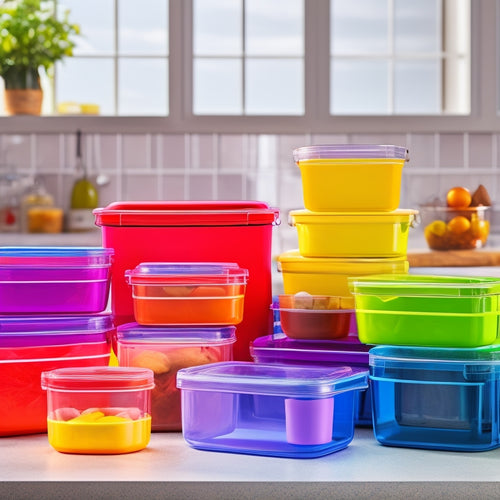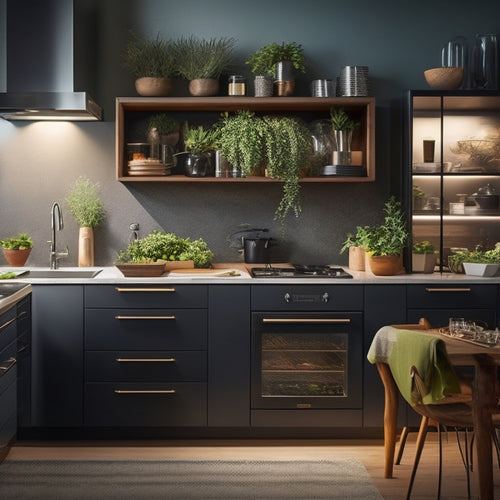
Why Small Kitchen Organization Systems Matter Most
Share
You rely heavily on your kitchen, and when it's small, every inch counts, making a well-designed organization system essential to your cooking productivity and sanity. A clutter-free kitchen not only reduces stress but also saves you time and energy. By maximizing space, utilizing essential storage solutions, and streamlining workflow efficiency, you can create a functional kitchen that works with you, not against you. Customizing your organization system to fit your cooking habits and style further boosts productivity. Discover how a tailored approach can transform your kitchen into a haven of efficiency, allowing you to cook, create, and thrive.
Key Takeaways
• Small kitchen organization systems maximize space, reducing clutter and increasing productivity in compact areas.
• Effective systems streamline workflow, saving time and reducing stress in meal preparation and cleanup.
• Customized storage solutions cater to individual cooking habits, promoting convenience and efficiency.
• Clutter-free countertops and organized storage improve focus, reducing procrastination and increasing overall satisfaction.
• Implemented systems help maintain a functional and efficient kitchen, reflecting personal style and promoting a sense of accomplishment.
Maximizing Space in Small Kitchens
To maximize space in your small kitchen, begin by evaluating the layout and identifying areas where you can optimize storage and functionality. A well-planned cabinet configuration can make a significant difference in the overall efficiency of your kitchen. Consider installing cabinets that go up to the ceiling to maximize vertical storage and keep frequently used items within easy reach.
Don't forget to utilize those often-wasted corner spaces. Corner shelves, carousels, or lazy susans can help you make the most of these areas, providing easy access to items that might otherwise be hard to reach. By optimizing corner utilization, you'll be able to store more items in less space, keeping your countertops clear and clutter-free.
Essential Storage Solutions for Clutter
Five essential storage solutions can help you tame the clutter that's taking over your small kitchen. When you're dealing with Pantry Purge and Countertop Chaos, it's easy to feel overwhelmed. But with the right storage solutions, you can create a more organized and peaceful cooking space.
Here are three essential storage solutions to get you started:
-
Adjustable shelves: These allow you to customize your storage space to fit your specific needs. Whether you need to store large appliances or small spices, adjustable shelves can help you make the most of your kitchen's vertical space.
-
Drawer dividers: These help keep your kitchen drawers organized and clutter-free. By separating your utensils, cookware, and dishes into designated compartments, you can quickly find what you need and avoid wasting time searching for it.
-
Magnetic spice strips: These are perfect for small kitchens with limited wall space. By storing your spices on the side of a cabinet or fridge, you can keep them within easy reach while keeping your countertops clear.
Streamlining Kitchen Workflow Efficiency
As you've optimized your kitchen's storage capacity, you're now ready to fine-tune your workflow to maximize efficiency and make meal prep a breeze. Streamlining your kitchen workflow is important to saving time, reducing stress, and delivering delicious meals to your loved ones.
To achieve this, focus on Task Prioritization. Identify the most essential tasks, such as meal planning, grocery shopping, and food preparation, and tackle them first. This guarantees that you're addressing the most vital aspects of meal prep, allowing you to allocate your time and energy wisely.
Next, implement Time Blocking to schedule specific tasks into dedicated time slots. This could include allocating 30 minutes for meal planning, 1 hour for grocery shopping, and 2 hours for food preparation. By doing so, you'll create a structured workflow that helps you stay focused, avoid procrastination, and make the most of your time.
Customizing Your Kitchen Organization
By tailoring your kitchen organization to your unique needs and preferences, you'll be able to create a space that truly supports your cooking style and habits. This is where customization comes in – it's about designing a system that reflects your personal style and caters to your specific requirements. With design flexibility, you can create a kitchen that not only looks great but also functions efficiently.
Here are three ways to customize your kitchen organization:
-
Assess your cooking habits:
Think about the types of dishes you cook most often and the utensils you use regularly. This will help you determine the most convenient storage locations and layouts. -
Choose adjustable storage solutions:
Opt for shelves, drawers, and cabinets that can be easily adjusted or rearranged as your needs change. -
Incorporate personalized accessories:
Add decorative touches, such as custom knobs or a kitchen sign, to make your space truly yours.
Boosting Productivity With Systems
You can maximize your kitchen's potential by implementing systems that streamline your workflow, reducing clutter and increasing efficiency. By doing so, you'll free up time to focus on what matters most - serving others.
With a well-organized kitchen, you'll be able to prepare meals quickly and confidently, ensuring that you can provide for your loved ones or customers.
To take your productivity to the next level, consider incorporating time blocking into your daily routine. This involves dedicating specific times of the day to specific tasks, such as meal prep or cleanup.
By doing so, you'll be able to manage your time more effectively and stay on track. Additionally, understanding your personal rhythms - or the times of day when you're most energized and focused - can help you optimize your workflow.
For example, if you're a morning person, consider tackling complex cooking tasks then, and save simpler tasks for later in the day. By combining time blocking with an understanding of your personal rhythms, you'll be able to boost your productivity and achieve your goals.
Frequently Asked Questions
Can I Install Kitchen Organization Systems Myself or Do I Need a Professional?
You can try DIY kitchen organization systems, but be prepared for DIY frustrations like measuring mistakes and wasted time. Consider hiring a pro to guarantee a smooth, customized installation that maximizes your space.
How Do I Choose the Right Materials for My Kitchen Organization System?
You'll want to choose materials that balance durability and style, considering factors like moisture resistance, stain tolerance, and color schemes that complement your kitchen's aesthetic, ensuring a functional and visually appealing organization system.
Are Kitchen Organization Systems Worth the Investment for a Small Kitchen?
You're wondering if kitchen organization systems are worth the investment for your small kitchen. They absolutely are! You'll reap cost benefits from reduced food waste and increased efficiency, plus enjoy significant space savings from optimized storage and clutter-free countertops.
Can Kitchen Organization Systems Be Adapted for Kitchens With Unique Shapes?
"It's no coincidence you're wondering if kitchen organization systems can adapt to unique kitchen shapes! You'll be happy to know that angular layouts can be tamed with custom solutions, while curved solutions can be cleverly designed to maximize space."
How Often Should I Reorganize and Update My Kitchen Organization System?
You should reorganize and update your kitchen organization system every 2-3 months for a Seasonal Refresh, and make it a Habit Formation by scheduling it in your calendar to guarantee your kitchen remains clutter-free and functional.
Related Posts
-

Stackable Kitchen Containers for Modular Systems
Stackable kitchen containers for modular systems change your cooking space by maximizing vertical storage and enhanci...
-

Top-Rated Dish Drainers for Kitchen Use
Top-rated dish drainers enhance your kitchen's efficiency and aesthetics. You'll find compact designs that save preci...
-

Smart Kitchen Countertop Storage Innovations
Smart kitchen countertop storage innovations are transformative for maximizing your kitchen's potential. You can clea...


